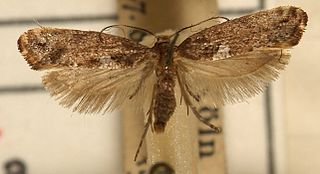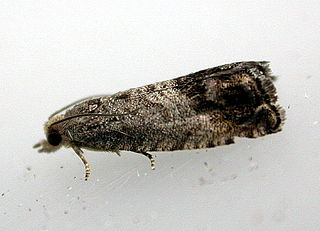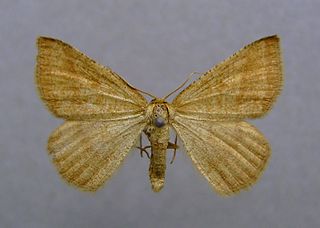
The peppered moth is a temperate species of night-flying moth. It is mostly found in the northern hemisphere in places like Asia, Europe and North America. Peppered moth evolution is an example of population genetics and natural selection.

The luna moth, also called the American moon moth, is a Nearctic moth in the family Saturniidae, subfamily Saturniinae, a group commonly named the giant silk moths.

The geometer moths are moths belonging to the family Geometridae of the insect order Lepidoptera, the moths and butterflies. Their scientific name derives from the Ancient Greek geo γεω, and metron μέτρον "measure" in reference to the way their larvae, or inchworms, appear to measure the earth as they move along in a looping fashion. Geometridae is a very large family, containing around 23,000 described species; over 1400 species from six subfamilies are indigenous to North America alone. A well-known member is the peppered moth, Biston betularia, which has been the subject of numerous studies in population genetics. Several other geometer moths are notorious pests.

The de Havilland Gipsy Major or Gipsy IIIA is a four-cylinder, air-cooled, inverted inline engine used in a variety of light aircraft produced in the 1930s, including the famous Tiger Moth biplane. Many Gipsy Major engines still power vintage aircraft types.

The slender pug is a moth of the family Geometridae. It was first described by Jacob Hübner in 1813 and is found throughout Europe and western parts of the Palearctic. The larva feeds on the catkins of willow.

The Acrolepiidae are a family of moths known as false diamondback moths. In modern classifications, they are often treated as a subfamily (Acrolepiinae) of the family Glyphipterigidae.

Nepticulidae is a family of very small moths with a worldwide distribution. They are characterised by eyecaps over the eyes. These pigmy moths or midget moths, as they are commonly known, include the smallest of all living moths, with a wingspan that can be as little as 3 mm in the case of the European pigmy sorrel moth, but more usually 3.5–10 mm. The wings of adult moths are narrow and lanceolate, sometimes with metallic markings, and with the venation very simplified compared to most other moths.

The orange swift or orange moth is a moth belonging to the family Hepialidae. The species was first described by Carl Linnaeus in 1761 and was previously placed in the genus Hepialus. It is distributed throughout Europe.

The de Havilland Gipsy is a British air-cooled four-cylinder in-line aircraft engine designed by Frank Halford in 1927 to replace the ADC Cirrus in the de Havilland DH.60 Moth light biplane. Initially developed as an upright 5 litre capacity engine, later versions were designed to run inverted with increased capacity and power.

The bird-cherry ermine is a species of moth in the family Yponomeutidae, the ermine moths. The wingspan of the moth ranges from 16 to 25 mm. The insect was first described in 1758 by the Swedish naturalist Carl Linnaeus who gave it the name Phalaena evonymella; it was later transferred to the genus Yponomeuta, becoming Yponomeuta evonymella. The moth can be found in the whole of Europe and the northern and eastern part of Asia.

Rhodometra sacraria, the vestal, is a moth of the family Geometridae. The species was first described by Carl Linnaeus in his 1767 12th edition of Systema Naturae.

Pandemis heparana, the dark fruit-tree tortrix or apple brown tortrix, is a moth of the family Tortricidae.

Cydia nigricana, the pea moth, is a moth of the family Tortricidae. It is found in Europe.

The hemlock moth, also known as the defoliating hemlock moth or poison hemlock moth, is a nocturnal moth species of the family Depressariidae. Of Palaearctic origin, it was first found in North America in 1973 when it was accidentally introduced. The moth is now widespread throughout the northern half of the United States, southern Canada, northern Europe, and, more recently, New Zealand and Australia. The larval form grows to around 10 mm, while the adults wingspan is between 17 mm and 19 mm.

Cydia splendana, the chestnut tortrix, is a moth of the family Tortricidae. It is found in Europe. It is also known as the acorn moth, but this can also refer to Blastobasis glandulella from North America, which belongs to the more primitive family Blastobasidae.

Aplasta is a monotypic moth genus in the family Geometridae erected by Jacob Hübner in 1823. Its only species, Aplasta ononaria, the rest harrow, was first described by Johann Kaspar Füssli in 1783. It is found in southern Europe to Anatolia and from England to the Baltic states.

Homoeosoma nimbella is a moth of the family Pyralidae. It is found in Europe.

Thaumatotibia (Cryptophlebia) leucotreta, commonly known as the false codling moth, orange moth, citrus codling moth or orange codling moth, is a moth in the family Tortricidae under the order of Lepidoptera. Larvae of the moth feed on a wide range of crops from cotton and macadamia nuts to Citrus species. The larvae have a less selective diet than the codling moth, which feeds primarily on temperate fruit crops.

The Erebidae are a family of moths in the superfamily Noctuoidea. The family is among the largest families of moths by species count and contains a wide variety of well-known macromoth groups. The family includes the underwings (Catocala); litter moths (Herminiinae); tiger, lichen, footman and wasp moths (Arctiinae); tussock moths (Lymantriinae), including the arctic woolly bear moth ; fruit-piercing moths ; micronoctuoid moths (Micronoctuini); snout moths (Hypeninae); and zales, though many of these common names can also refer to moths outside the Erebidae. Some of the erebid moths are called owlets.

Xyloryctidae is a family of moths contained within the superfamily Gelechioidea described by Edward Meyrick in 1890. Most genera are found in the Indo-Australian region. While many of these moths are tiny, some members of the family grow to a wingspan of up to 66 mm, making them giants among the micromoths.



















